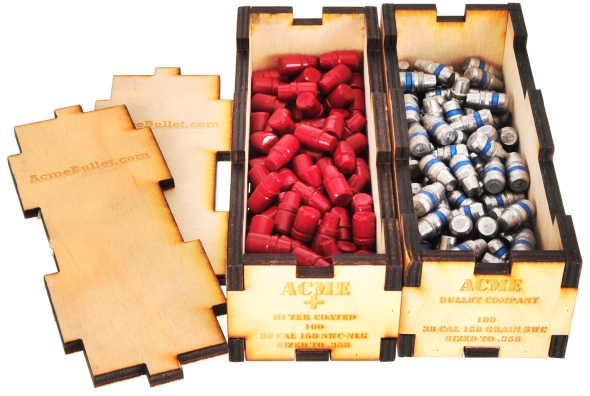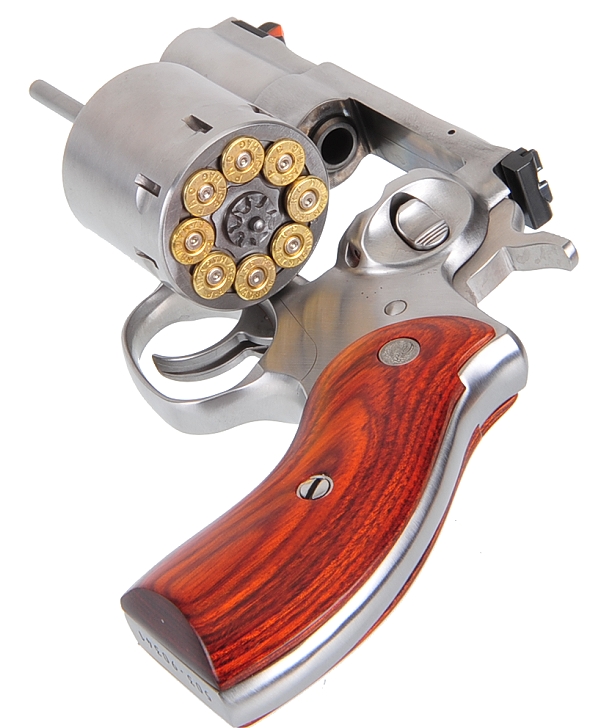
Shooting the Ruger with factory ammo was a good experience and, quite frankly, the velocity results were better than I anticipated with its 2.75″ barrel. The opportunity I didn’t have in Part I was to shoot the Redhawk with handloads; some moderate penetrating jacketed types and some less likely to expand and would not let a little bone and gristle deter their journey. It is the latter that I would carry in the woods where penetration on heavy boned animals would be important.

| Bullet Manufacturer | Bullet Type |
Bullet Weight Grains |
Bullet Length “ |
Cannelure Crimp Groove Depth “ |
COL” |
| Remington | SJHP | 125 | 0.570 | 0.280 | 1.580 |
| Hornady | XTP/HP | 140 | 0.602 | 0.305 | 1.590 |
| Acme Cast Plain | SWC | 158 | 0.717 | 0.385 | *1.620 |
| Acme Cast Coated | SWC | 158 | 0.685 | 0.350 | *1.620 |
|
* Exceeds SAAMI Maximum COL |
|||||
A couple of notes on handloading the selected cast bullets. One our readers asked if we had worked with Acme Bullets. We had not. So we picked up some 158 grain cast, plain/lubed and coated and worked them into our handloads. Their bullets are 92-6-2 lead alloy, 92% Lead, 6% Antimony and 2% Tin for a Brinnel hardness of 16. The hardness will lead bores less and penetrate more.

The plain bullets receive Magma Engineering blue lube. The coated bullets are finished with Hi-Tek Supercoat, a self lubricating polymer finish that is bonded to the metal substrate. The result of coating is containment of lead and an absence of smoke from vaporized bullet lube. The Acme bullets are very really clean castings, very uniform in weight and priced right; $10.50/100 and shipping for 200 pieces was $6. Bullets are packaged in heavy plastic and shipped in reusable wooden boxes as pictured.
 The difference between the plain lead/lubed and the Supercoat bullets, I believe, has little to do with either bullet’s coefficient of friction and a lot to do with the physical form of the two bullets. The plain bullet has a longer conical nose and smaller meplat than the coated bullet. The plain bullet has a thinner front driving band, a longer and more pronounced crimp groove, a grooved shank for lube retention and a heavily chamfered heel. The coated bullet is made shorter to arrive at the same weight as the plain bullet to compensate for those physical differences.
The difference between the plain lead/lubed and the Supercoat bullets, I believe, has little to do with either bullet’s coefficient of friction and a lot to do with the physical form of the two bullets. The plain bullet has a longer conical nose and smaller meplat than the coated bullet. The plain bullet has a thinner front driving band, a longer and more pronounced crimp groove, a grooved shank for lube retention and a heavily chamfered heel. The coated bullet is made shorter to arrive at the same weight as the plain bullet to compensate for those physical differences.
In wet measurement, seated to the same cartridge overall length, the net capacity of the case with bullet seated is 0.5 grain greater for the coated bullet assembly. Loading to the same charges, the coated bullet ran approximately 120 fps faster than the plain bullet, without flattened primers or yielding cases that resisted extraction. That said, the velocity increase indicates an increase in pressure, as a result of an increase in bore friction…. which caused me to back off a half grain from the original handload data.

The SAAMI spec for the 357 Magnum case is 1.290″ +0.00/-0.020. PMC brass typically measures 1.285″, Remington brass typically measures 1.280. With a typical trim to length of 1.280″, either works well and is consistent with mainstream load data. Hornady decided to set their case length, brass and loaded 357 Mag ammo, out of spec at 1.240″ to accommodate the long nose on Hornady FTX bullets and allow them to function in firearms manufactured for use with SAAMI standard ammunition.
Unfortunately, that means mainstream reloading data no longer applies when using short Hornady cases. Seating any other manufacturer’s bullets to their cannelure would be 0.050″ deeper seated than spec which could significantly increase pressure.
Subsequently, anyone reloading must make a decision. Adjust powder charges to reflect the reduced net case capacity, short seat other manufacturer’s bullets and not use their cannelures, use Hornady FTX bullets and brass and Hornady data only. Skip reloading Hornady brass and use cases that are from manufacturers that produce to SAAMI spec.
 |
Warning: Bullet selections are specific, and loads are not valid with substitutions of different bullets of the same weight. Variations in bullet length will alter net case capacity, pressure and velocity. Primer selection is specific and primer types are not interchangeable. These are maximum loads in my firearms and may easily be excessive in others. All loads should be reduced by 5%, and developed following safe handloading practices as represented in established reloading manuals produced by component manufacturers. Presentation of these loads does not constitute a solicitation for their use, nor a recommendation.
|
||||||||||||||||||||||||||||||||||||||||||||||||||||||||||||||||||||||||||||||||||||||||||||||||||||||||||||||
|
|||||||||||||||||||||||||||||||||||||||||||||||||||||||||||||||||||||||||||||||||||||||||||||||||||||||||||||||
And then….
Noticeable at the end of range sessions with the Ruger Redhawk eight shot 357 Mag was the absence of sore knuckles, finger stings and muzzle blast headache. The 357 Mag Redhawk shoots like a longer barrel firearm. Could be heft or balance, but it is steady shooting and easy on the wrists. It would make an excellent trail gun and a heck of a plinker. Probably the softest shooting 357 Magnum I’ve ever shot.


Email Notification